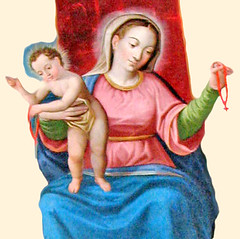Santa Lucia
However one interprets the saint's name, she is yet another of the company of Roman virgin-martyrs, whose brave witness to Christ for the sake of their purity or spiritual espousal to the Saviour, has so captured the imagination. She is said to have been a Sicilian, born in the city of Syracuse of noble and wealthy parents in the 4th-century. In the company of such luminaries as St Cecilia and St Agnes, St Lucy is one of the twenty two virgins depicted in the 6th-century mosaic frieze of the Procession of Virgins in the basilica of Sant' Apollinare Nuovo in Ravenna and also joins them in being honoured in the Roman Canon. She is also mentioned in the Ambrosian Canon and is found in the earliest Roman sacramentaries, in Greek liturgical books and in the marble calendar of Naples. She has also been frequently portrayed by artists and since the Middle Ages, she is often shown holding her eyes in a dish, based on the belief that she tore them out rather than to surrender to her attacker, a Roman soldier. As such she is the patroness of those with maladies of the eye! However, a less gruesome interpretation of this medieval attribution may be traced to Jacobus de Voragine's words above that it is through the eyes that we behold light and indeed, beauty and grace.
St Lucy's feast actually falls on the shortest day of the year (according to the Julian reckoning - which is actually today, the 13th of December - and it is especially celebrated in Sweden as a festival of light. It was called the "little Yule" in that country and marked the beginnings of the Christmas festivities, heralding the coming of Christ, the Light of the World. At the first cock-crow, between 1 and 4am, the prettiest girl in the Swedish household would go among the sleeping members of her family, dressed in a white robe - the mark of virginal purity, a red sash - reminder of St Lucy's martyrdom, and crowned with a wreath adorned with candles - the light of Lucy's nomenclature. She awakened the sleepers and regaled them with a sweet drink or with coffee and sang a song. As such, she was called a 'Lussibruden' or 'Lucy bride'. When everyone was dressed, breakfast was taken amidst the warm glow of many candles.
In Sicily, a bonfire was lit in the piazza and a procession with her statue made its way there to preside over the dancing and festivities in the light of the fire.
Here in Blackfriars Cambridge, the custom has developed of celebrating St Lucy's night with a bonfire, fireworks and poetry, songs and a small feast. I understand that typically one of the Dominican sisters will come dressed as St Lucy, with a wreath of candles on her head and that is a sight, I await with eagerness! Photos to come, if that happens!
Until then, may you too mark (in whatever way - light a candle!) this feast of light in expectation of and longing for Jesus Christ who illumines all, whose splendour radiates in the saints and whose holy brilliance never fades; He, the Light of the nations, who is to come!







0 Comments:
Post a Comment
<< Home